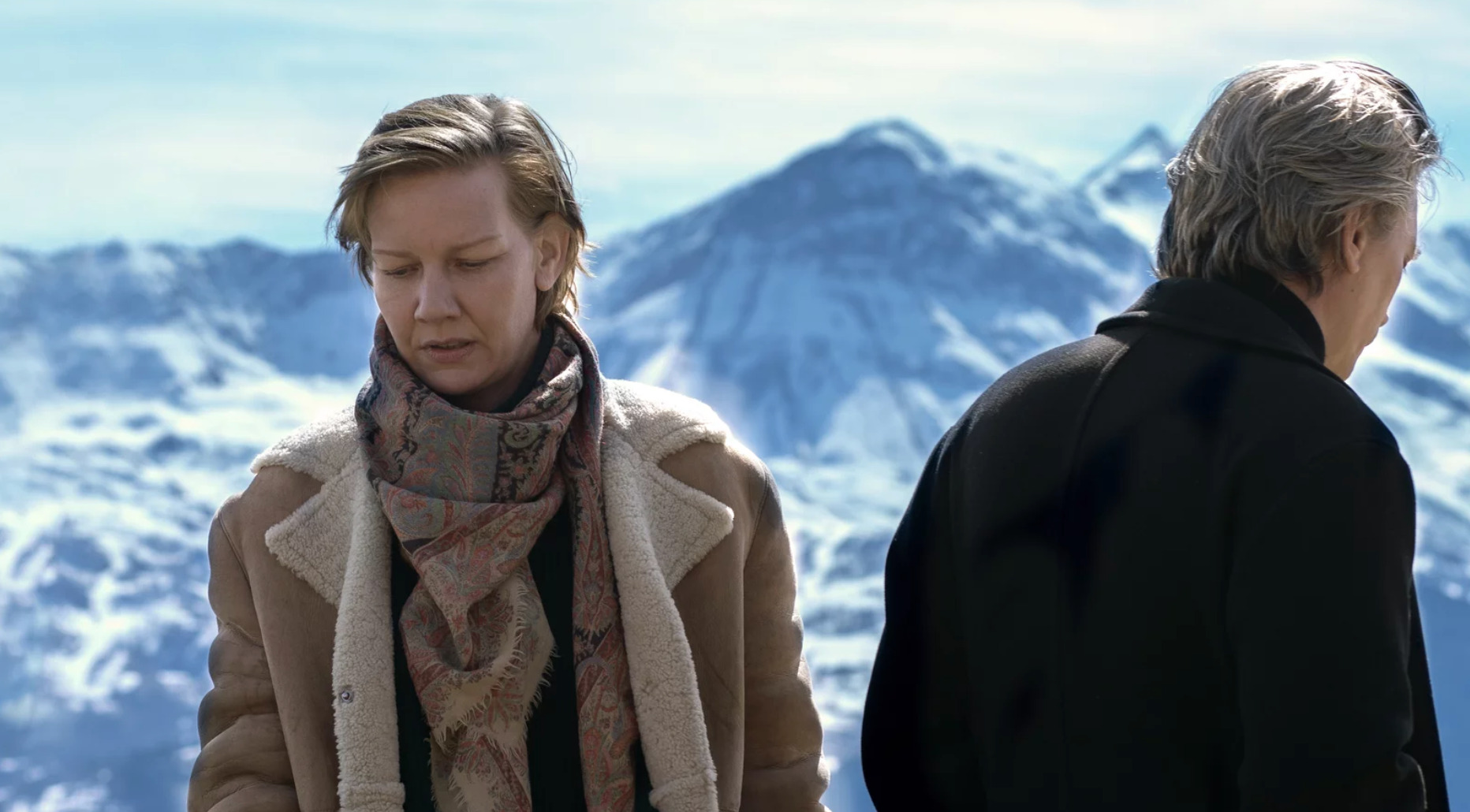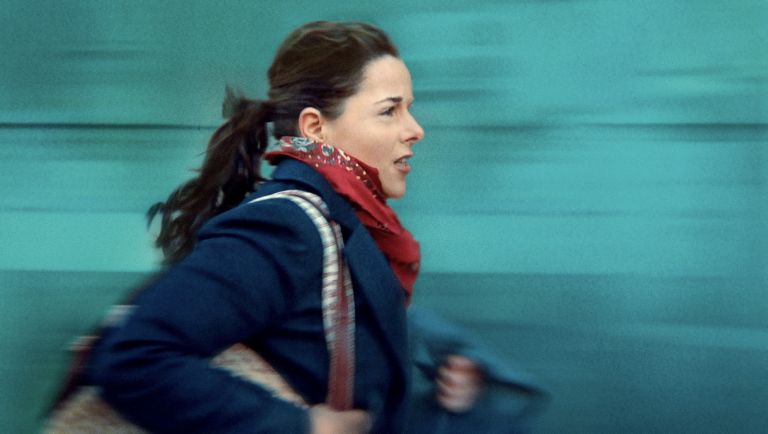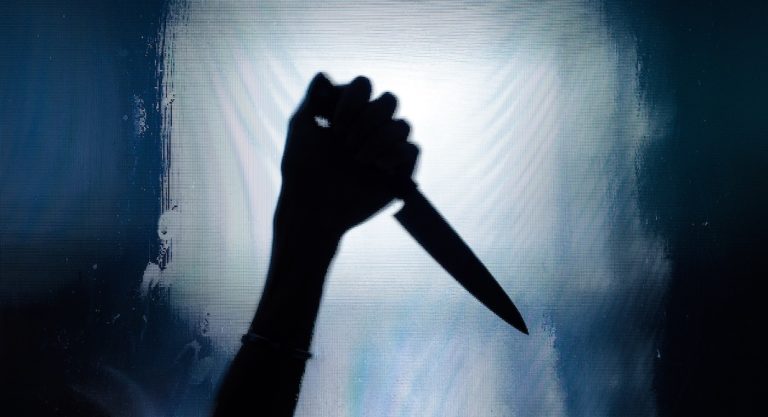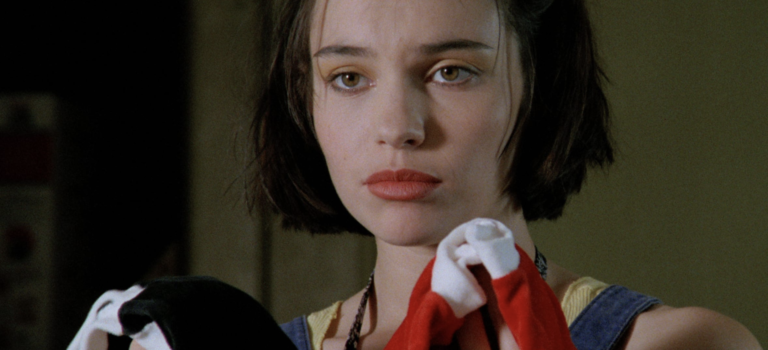When we meet Sandra Voyter in Justine Triet’s Palme d’Or-winning Anatomy of a Fall, a student is interviewing the respected author (Sandra Hüller) at her home in the French Alps. Or at least that’s the student’s intention. Sandra is more interested in her mid-afternoon wine than the interview, the deep red liquid bringing a playful gleam to her eye. She dodges most of the questions. Upstairs, Sandra’s eleven-year-old son Daniel (Milo Machado Graner) is washing the family dog, Snoop. Every time we cut to the bathroom, to see Daniel throwing a towel over Snoop or Snoop shaking out his fur, sending a spray across the room, we can still hear the incomprehensible rumble of the women’s voices from downstairs.
“You say your books always mix truth and fiction, and that makes us want to figure out which is which. Is that your goal?” the student (Camille Rutherford) asks, and we strain to hear Sandra’s response over Daniel’s shrieks of irritation and delight. What we know is the writer is more interested in the student’s life and passions than revealing her own. The whole time, the camera remains tight on the pair, giving their interaction an air of intimacy, their faces the focal point, the background blurring around them. There’s a playful charge in the air, as Sandra’s focus bounces around like the ball in a pinball machine. Then, the women’s conversation is derailed completely by the deafening Caribbean rhythms of Bacao Rhythm & Steel Band’s cover of rapper 50 Cent’s “P.I.M.P.” blasting upstairs. The student glances upwards, visibly irritated, while Sandra waves off the disruption. “It’s Samuel working upstairs, my husband,” she says.
The scene is a veritable master class in tension-building, introducing character, conflict and theme, layering recurring images, foreshadowing what is to come. We sense flirtatiousness in Sandra and feel the aggression Samuel is launching at his wife like a bomb before we’ve even met him. We detect storm clouds gathering in this cozy chalet where the family lives in the French Alps, and feel for their son Daniel, always a witness, dodging conflict when it erupts. It makes sense that the sequence begins with the dog’s ball haphazardly tumbling down the staircase, a visual nod to the titular fall to come.
Sandra halts the interview. Too much is happening. It’s impossible. Samuel has gotten his way. As Sandra’s disappointed new friend crosses the snow-caked driveway to her car, Daniel escapes for a walk with the dog and Sandra waves from the balcony. When Daniel returns sometime later, we meet Samuel for the first time: his body lying on the hard snow, his head in a puddle of blood. Over the persistent sounds of “P.I.M.P,” still playing on a loop, Daniel cries out for his mother.

When the evidence suggests that Samuel was hit with a heavy object prior to falling from the attic window, Sandra becomes the prime suspect in a murder investigation. Of course, she proclaims her innocence, and we learn quickly that she’s honest to a fault. When her lawyer (Swann Arlaud) asks if Samuel might have killed himself, she briefly entertains the idea before announcing it doesn’t sound like her husband, only to be chastened: This is no time to dismiss alternative theories. They need to convince a jury.
The suicide hypothesis is not farfetched. Samuel (Samuel Theis) has suffered extreme guilt and self-recrimination since an accident left Daniel partially blind, which occurred when Samuel was supposed to be watching him. He’s also frustrated with his life: He’s a teacher and he homeschools Daniel, but what he really wants to do is write.
The film evolves into a courtroom drama—with the requisite investigation, interrogations, and a high-profile trial—but Triet seems to have little interest in revealing whodunnit. Her subject is the mangled blood and guts of a marriage that may or may not have ended in murder—as well as the slipperiness of the truth. In the film’s climax, the prosecution introduces a taped argument between Sandra and Samuel the day before his death that he recorded as research for a writing project. Their voices—initially calm, then building toward a crescendo of blame, recrimination and violence—reverberates through the courtroom. The film audience gets to watch the scene play out in a flashback.
To some, their fight will seem like the kind of knock-down-drag-out that any married person will recognize. Sandra is a woman who has achieved more professional success than her husband, and he resents her for it. She has thrived as a novelist, which was once Samuel’s goal. He asks her to take on more of the domestic work, to give him time to write. Sandra is unwilling to make this compromise. Her husband has lain his own trap, she says, and she refuses to take the blame. To some, the argument is a familiar power struggle, a woman standing up for herself, acting out an all-too-familiar domestic dispute. To others, it’s evidence and motive all wrapped up with a bright, shiny bow. But it’s also important to recognize that neither Sandra nor Samuel is portrayed as being inherently wrong. Each simply sees their relationship through their own lens. Both are telling the truth as they see it. And that—the nature of truth—lies at the center of the film.

Pivotal to the prosecution’s and defense’s search for truth is Daniel, Sandra and Samuel’s young son who becomes a central witness for both sides and the beating heart of a film with no easy answers. He was there before and after his father’s death. He’s still reeling from it. He cannot see well, but has been asked repeatedly to interpret what he heard. He loves both his parents. He wants to believe his mother, but the evidence unnerves him, making him question everything he thought he knew about his parents. He pours his raging emotions into playing music on the piano. That music becomes the film’s emotionally charged soundtrack. Daniel’s testimony will be crucial, and he wants to get it right.
Ultimately, this is a movie about a marriage. It’s also about a writer couple whose lives bleed into their work, who write worlds that aren’t entirely their own, but that readers will be tempted to mine for truth, for evidence. The experience of watching the complex, thrilling story, provides a slow-burn tension that, like most murder mysteries, forces us to listen and watch intently, sifting through the evidence, struggling to discern if Sandra did it or not. Hüller’s performance as the often cold and unreadable Sandra, whose warmth emerges in rare instances—with her son and the young, attractive student in the opening scene, or while blowing off steam drinking with her lawyers—is phenomenally compelling and key to our desire to both believe her and wonder if she’s hiding something.
Some will be frustrated that Triet offers no easy answers, but it’s best to put genre expectations aside. We might never know what happened up there on the mountain, but maybe that’s alright. The towering mountains surrounding the family’s home bear witness. They look coldly down upon us, as if to say that no person can know another entirely. Sometimes the truth is unknowable. Can a jury get it right every time? The innocent are often found guilty, the guilty set free. Trying to discern the truth from Sandra Hüller’s face is a useless exercise. Instead, take in the cold, chiseled beauty of the Alps. Have a glass of wine and let your mind churn with all the film offers us to consider.
Anatomy of a Fall opened in New York and Los Angeles on October 13, 2023, followed by a national rollout on October 27.
Andrea Meyer has written creative treatments for commercial directors, a sex & the movies column for IFC, and a horror screenplay for MGM. Her first novel, Room for Love (St. Martin’s Press) is a romantic comedy based on an article she wrote for the New York Post, for which she pretended to look for a roommate as a ploy to meet men. A long-time film and entertainment journalist and former indieWIRE editor, Andrea has interviewed more actors and directors than she can remember. Her articles and essays have appeared in such publications as Elle, Glamour, Variety, Time Out NY, and the Boston Globe.
This article was originally published on October 20, 2023.






